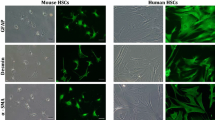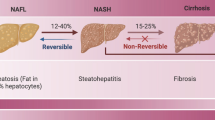Summary
The differentiation status in cultures of primary rat liver parenchymal cells was determined by measuring the activities of various xenobiotic metabolizing enzymes. Most enzyme activities dropped rather rapidly in monocultures of parenchymal cells. The protein content and the activities of cytosolic epoxide hydrolase, glutathione S-transferase, andα-naphthol UDP-glucuronosyl transferase were, however, well stabilized in 7-day-old co-cultures of parenchymal cells with two different lines of rat liver nonparenchymal epithelial cells (NEC1 and NEC2). Phenol sulfotransferase and microsomal epoxide hydrolase activity were reduced in this coculture system after 7 days to about 30 and 20% of the initial activity. Generally, higher enzyme activities were measured in co-cultures with one specific epithelial cell line (NEC2) as compared to those with the other line (NEC1). C3H 10T1/2 mouse embryo fibroblasts supported the parenchymal cells even better than the two epithelial lines, because the activity of microsomal epoxide hydrolase was also stabilized. Glutathione transferase activity was increased over time in this co-culture system. Our results show that the differentiation status of liver parenchymal cells was much better stabilized in co-cultures than in monocultures but that, depending on the type of cells used for co-culture, great quantitative differences existed. The entire pattern of xenobiotic metabolizing enzyme activities could not be stabilized at the kind of levels found in freshly isolated parenchymal cells.
Similar content being viewed by others
References
Arand, M.; Robertson, L. W.; Oesch, F. A fluorometric assay for quantitating phenol sulfotransferase activities in homogenates of cells and tissues. Anal. Biochem. 163:546–551; 1987.
Begue, J. M.; Guguen-Guillouzo, C.; Pasdeloup, N., et al. Prolonged maintenance of active cytochrome P-450 in adult rat hepatocytes co-cultured with another liver cell type. Hepatology 4:839–842; 1984.
Bock, K. W.; White, I. N. H. UDP-Glucuronosyltransferase in perfused rat liver and in microsomes: influence of phenobarbital and 3-methylcholanthrene. Eur. J. Biochem. 46:451; 1974.
Donato, M. T.; Gómez-Lechón, M. J.; Castell, J. V. Drug metabolizing enzymes in rat hepatocytes co-cultured with cell lines. In Vitro Cell. Dev. Biol. 26:1057–1062; 1990.
Edelman, G. M. Specific cell adhesion in histogenesis and morphogenesis. In: Edelman, G. M.; Thiery, J. P., eds. The cell in contact; adhesions and junctions as morphogenetic determinants. New York: John Wiley & Sons; 1985:139–168.
Guguen-Guillouzo, C.; Clément, B.; Baffet, G., et al. Maintenance and reversibility of active albumin secretion by adult rat hepatocytes co-cultured with another liver epithelial cell type. Exp. Cell Res. 143:47–54; 1983.
Guzelian, P. S.; Li, D.; Schuetz, E. G., et al. Sex change in cytochrome P-450 phenotype by growth hormone treatment of adult rat hepatocytes maintained in a culture system on matrigel. Proc. Natl. Acad. Sci. USA 85:9783–9787; 1988.
Habig, W. H.; Pabst, M. J.; Jakoby, W. B. Glutathione S-transferases. The first enzymatic step in mercapturic acid formation. J. Biol. Chem. 249:7130–7139; 1974.
Jauregui, H. O.; McMillan, P. N.; Driscoll, J., et al. Attachment and long-term survival of adult rat hepatocytes in primary monolayer cultures: comparison of different substrata and tissue culture media formulations. In Vitro Cell. Dev. Biol. 22:13–22; 1986.
Kuri-Harcuch, W.; Mendoza-Figueroa, T. Cultivation of adult rat hepatocytes of 3T3 cells: expression of various liver differentiation functions. Differentiation 41:148–157; 1989.
Langenbach, R.; Malick, L.; Tompa, A., et al. Maintenance of adult rat hepatocytes on 10T1/2 cells. Cancer Res. 39:3509–3514; 1979.
Lowry, O. H.; Rosebrough, W. J.; Farr, A. L., et al. Protein measurement with the Folin phenol reagent. J. Biol. Chem. 193:265–275; 1951.
Maier, P. Development of in vitro toxicity tests with cultures of freshly isolated rat hepatocytes. Experientia 44:807–817; 1988.
Meredith, M. J. Rat hepatocytes prepared without collagenase: prolonged retention of differentiated characteristics in culture. Cell Biol. Toxicol. 4:405–425; 1988.
Michalopoulos, G.; Russell, F.; Biles, C. Primary cultures of hepatocytes on human fibroblasts. In Vitro 15:796–806; 1979.
Michalopoulos, G.; Sattler, C. A.; Sattler, G. L., et al. Cytochrome P-450 induction by phenobarbital and 3-methylcholanthrene in primary cultures of hepatocytes. Science 193:907–909; 1976.
Morim, O.; Normand, C. Long-term maintenance of hepatocyte functional activity in co-culture: requirements for sinusoidal endothelial cells and dexamethasone. J. Cell. Physiol. 129:103–110; 1986.
Muakkassah-Kelly, S. F.; Bieri, F.; Waechter, F., et al. Long-term maintenance of hepatocytes in primary culture in the presence of DMSO: further characterization and effect of Nafenopin, a peroxisome proliferator. Exp. Cell Res. 171:37–51; 1987.
Oesch, F. Purification and specifity of a microsomal human epoxide hydrase. Biochem. J. 139:77–88; 1974.
Oesch, F.; Jerina, D. M.; Daly, J. A radiometric assay for hepatic epoxide hydrase activity with 7-3H-styrene oxide. Biochim. Biophys. Acta 227:685–691; 1971.
Oesch, F.; Sparrow, A. J.; Platt, K. L. Radioactively labelled epoxides, part II: tritium labelled cyclohexene oxide, trans-stilbene oxide and phenanthrene 9,10-oxide. J. Labelled Compd. & Radipharm. 17:93–102; 1980.
Rojkind, M.; Gatmaitan, Z.; Mackensen, S., et al. Connective tissue biomatrix: its isolation and utilization for long-term cultures of normal rat hepatocytes. J. Cell Biol. 87:255–263; 1980.
Sawada, N.; Tomomura, A.; Sattler, C. A., et al. Effects of extracellular matrix components on the growth and differentiation of cultured rat hepatocytes. In Vitro Cell. Dev. Biol. 23:267–273; 1987.
Schladt, L.; Wörner, W.; Setiabudi, F., et al. Distribution and inducibility of cytosolic epoxide hydrolase in male Sprague-Dawley rats. Biochem. Pharmacol. 35:3309–3316; 1986.
Schrode, W.; Mecke, D.; Gebhard, R. Induction of glutamine synthetase in periportal hepatocytes by cocultivation with a liver epithelial cell line. Eur. J. Cell Biol. 53:35–41; 1990.
Traub, O.; Look, J.; Dermietzel, R., et al. Comparative characterization of the 21-kD and 26-kD gap junction proteins in murine liver and cultured hepatocytes. J. Cell Biol. 108:1039–1051; 1989.
Utesch, D.; Molitor, E.; Platt, K. L., et al. Differential stabilization of cytochrome P-450 isoenzymes in primary cultures of adult rat liver parenchymal cells. In Vitro Cell. Dev. Biol. 27A:858–863; 1991.
Vandenberghe, Y.; Andreé, F.; Rogiers, V., et al. Changes in expression and “de novo” synthesis of glutathione S-transferase subunits in cultured rat hepatocytes. Biochem. Pharmacol. 39:685–690; 1990.
Wang, S. R.; Renaud, G.; Infante, J., et al. Isolation of rat hepatocytes with EDTA and their metabolic functions in primary culture. In Vitro Cell. Dev. Biol. 21:526–530; 1985.
Wanson, J. C.; Mosselmans, R.; Brouwer, A., et al. Interaction of rat hepatocytes and sinusoidal cells in culture. Biol. Cell. 36:7–16; 1979.
Williams, G. M.; Gunn, J. M. Long-term cell culture of adult rat liver epithelial cells. Exp. Cell Res. 89:139–142; 1974.
Author information
Authors and Affiliations
Rights and permissions
About this article
Cite this article
Utesch, D., Oesch, F. Dependency of the in vitro stabilization of differentiated functions in liver parenchymal cells on the type of cell line used for co-culture. In Vitro Cell Dev Biol - Animal 28, 193–198 (1992). https://doi.org/10.1007/BF02631091
Received:
Accepted:
Issue Date:
DOI: https://doi.org/10.1007/BF02631091




